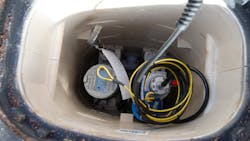With leakage reduction likely to be imperative to water companies’ net zero-carbon strategies, Tom Cork, channel sales director at technology company Ovarro, explains why smarter detection can support the drive to protect resources and use less energy.
Why can leaking pipes lead to an increase in carbon emissions?
The water sector has a major role to play in the US meeting its goals to halve the greenhouse gas emissions by 2030 and reach net zero by 2050. Water and wastewater operations typically contribute 30-40% to a municipality’s total energy use and the global sector is currently estimated to contribute up to 5% of greenhouse gas emissions. The link between leakage and carbon should not be underestimated.
The pumping of treated water is particularly energy-intensive, so leakage reduction should be a key feature of water companies’ carbon strategies, along with other methods of water loss management and water efficiency programmes. If a municipality is able to reduce the amount of water being treated and put into supply, it will reduce the amount of energy being consumed, leading to a drop in operational carbon emissions.
In addition, leaking pipework can also mean lower pressure and customer impact of loss of supplies, whilst the distribution network has issues with pumps working harder, consuming more power.
What new solutions should municipalities be considering?
The 2021 Drinking Water infrastructure report from The American Society of Civil Engineers says there is a water main break in the US every two minutes losing an estimated 6 billion gallons of water each day.
As customer expectations mount, both for leak management and wider carbon reduction and environmental protection, it is clear municipalities in every state must find smarter ways to address leakage on the nation’s ageing and historically under-funded water supply networks. A commitment to unprecedented levels of investment into water infrastructure made by President Biden should set the stage for the adoption of new technological solutions.
To address leaking pipes, tools that enable local and remote detection will perhaps present the most interest to water companies – and the good news is the increased availability and falling cost of real-time leak detection technology.
Acoustic loggers that can pinpoint leaks remotely by measuring the sound generated by water escaping the network are front-of-field in the digital revolution. These include Ovarro’s Enigma range, developed in collaboration with UK water companies, which are seeing impressive results for utilities in the UK, Europe, Middle East and Asia regions.
How can cloud-based, data-led solutions advance traditional leak detection efforts?
Ovarro has cloud-based analytics platform, PrimeWeb, where clients are given GPS imagery which accurately pin-points points of interest, in most cases within five metres of the leak. This UK-patented mathematical correlation technique is fundamental the operation of the Enigma portfolio. In the event of a leak between two loggers, the noise emitted takes a measurable amount of time to reach each logger. A set of digital signal processing algorithms correlates the two recordings to determine the time difference between the sounds.
The speed that the sound travels through the pipe, which differs depending on pipe material, and the distance between the loggers is processed through an algorithm that computes the leak location, crucially, speeding up the repairs and reducing the amount of water lost. This level of accuracy was not possible via traditional acoustic detection, bringing this technology to forefront of fixed network solutions.
The sensors are also effective in finding leaks over long distances and inside plastic pipes. Historically, one of the industry’s biggest challenges was detecting leaks on plastic pipes as they do not transmit high levels of noise when they leak.
What other benefits can be gained?
Having the ability to precisely pinpoint leaks enables utilities to monitor networks continuously and in real-time. Operational field detection costs will be saved as leakage teams can be utilised better, with greater success and there will be less above-ground disruption.
This will see the technology play a key role in the creation of smart water networks, helping companies become more proactive in their operations and less reactive. Faster, more streamlined adoption by utilities would accelerate tangible benefits in consumption, cost efficiency and energy reduction.



